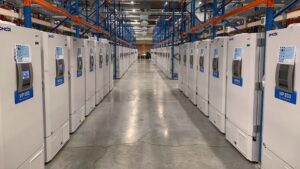
Ukraine, with financial support from the U.S. government, will receive $2.8 million worth of refrigeration equipment for storing COVID-19 vaccines at primary health care facilities and when using by mobile teams.
According to a press release from UNICEF, which supplied the equipment, funds for the purchase of the equipment were provided by USAID.
Some 3,100 vaccination points, 1,034 of which operate on the basis of primary health care facilities, and 800 mobile teams, will receive equipment.
The equipment includes 5,643 thermal containers, 8,100 thermal bags, 197,730 ice packs and 27,486 temperature monitoring devices.
The first batch of equipment was delivered on September 30 and includes 2,700 thermal bags in which COVID-19 vaccines can be stored at temperatures from +2 to + 8 ° C.
In the future, this equipment can be used for the transportation and storage of vaccines provided for by the national immunization schedule.
Currently, USAID has allocated about $10 million to support vaccinations in Ukraine and donated almost $2.2 million of COVID-19 vaccines to Ukraine as part of the COVAX mechanism.
National bank of Ukraine’s official rates as of 25/10/21

Source: National Bank of Ukraine
Ukrainian banks’ cash exchange rates on 23/10/21

Source: Interfax-Ukraine

Industrial production in Ukraine in September 2021 decreased by 0.7% compared to September 2020, while in August its growth was 0.6%, in July – 0.2%, in June – 1.1%, the State Statistics Service has reported.
The department clarified that, adjusted for the effect of calendar days, industrial production in September 2021 from September 2020 decreased by 0.9% against 0.2% in August, 0.9% in July and 0.7% in June.
The State Statistics Service indicates that compared with August this year, industrial production in the country increased by 2.9%, and, taking into account the seasonal adjustment, decreased by 1.8%.
In processing industry in September 2021 from September 2020, production decreased by 1.1%, in the supply of electricity, gas, steam and conditioned air – by 2.4%, in extracting industry and quarrying – increased by 1%.
In general, over the nine months of this year, industrial production in Ukraine increased by 1.4% compared to the same period last year, in particular in processing industry – by 1.6%, in the supply of electricity, gas, steam and conditioned air – by 1.2%, in extracting industry and quarrying – by 1.2%.
As reported, industrial production in Ukraine in 2020 fell by 5.2% after falling by 0.5% a year earlier.
MAIN TRADE PARTNERS OF UKRAINE IN % FROM TOTAL VOLUME (IMPORT FROM OTHER COUNTRIES TO UKRAINE) JAN-JUNE 2021
